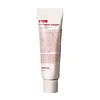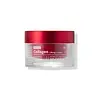What's inside
What's inside
 Key Ingredients
Key Ingredients

 Benefits
Benefits

 Concerns
Concerns

 Ingredients Side-by-side
Ingredients Side-by-side

Water
Skin ConditioningGlycerin
HumectantMethylpropanediol
SolventButylene Glycol
Humectant1,2-Hexanediol
Skin ConditioningNiacinamide
SmoothingCaprylic/Capric Triglyceride
MaskingCetearyl Olivate
Lactobacillus Ferment
Skin ConditioningSorbitan Olivate
EmulsifyingCetearyl Alcohol
EmollientCarbomer
Emulsion StabilisingTromethamine
BufferingPanthenol
Skin ConditioningBetaine
HumectantCetearyl Glucoside
EmulsifyingHydroxyethylcellulose
Emulsion StabilisingTrehalose
HumectantBifida Ferment Filtrate
Skin ConditioningLactococcus Ferment
Skin ConditioningGelatin
Hydrolyzed Collagen
EmollientDiospyros Kaki Leaf Extract
Skin ProtectingVitis Vinifera Fruit Extract
Skin ConditioningPolygonum Cuspidatum Root Extract
AntioxidantCoffea Arabica Seed Extract
MaskingCarthamus Tinctorius Flower Extract
Skin ConditioningAdenosine
Skin ConditioningCamellia Sinensis Leaf Extract
AntimicrobialCastanea Crenata Shell Extract
Skin ConditioningZanthoxylum Piperitum Fruit Extract
Skin ConditioningCellulose Gum
Emulsion StabilisingAllantoin
Skin ConditioningDipotassium Glycyrrhizate
HumectantCrataegus Cuneata Fruit Extract
Skin ConditioningPrunus Persica Fruit Extract
AbrasiveLithospermum Erythrorhizon Root Extract
Skin ConditioningPyrus Communis Fruit Extract
Skin ConditioningVanilla Planifolia Fruit Extract
Skin ConditioningMusa Sapientum Fruit Extract
Skin ConditioningHedera Helix Extract
AntimicrobialPinus Palustris Leaf Extract
TonicOenothera Biennis Flower Extract
AstringentPueraria Lobata Root Extract
HumectantUlmus Davidiana Root Extract
Skin ConditioningEthylhexylglycerin
Skin ConditioningGlycine
BufferingSerine
MaskingGlutamic Acid
HumectantSodium Hyaluronate
HumectantAspartic Acid
MaskingLeucine
Skin ConditioningHydrolyzed Hyaluronic Acid
HumectantAlanine
MaskingLysine
Skin ConditioningArginine
MaskingTyrosine
MaskingPhenylalanine
MaskingProline
Skin ConditioningThreonine
Valine
MaskingIsoleucine
Skin ConditioningDipeptide Diaminobutyroyl Benzylamide Diacetate
Skin ConditioningHistidine
HumectantCysteine
AntioxidantMethionine
Skin ConditioningPalmitoyl Tripeptide-5
Skin ConditioningSodium Acetylated Hyaluronate
HumectantWater, Glycerin, Methylpropanediol, Butylene Glycol, 1,2-Hexanediol, Niacinamide, Caprylic/Capric Triglyceride, Cetearyl Olivate, Lactobacillus Ferment, Sorbitan Olivate, Cetearyl Alcohol, Carbomer, Tromethamine, Panthenol, Betaine, Cetearyl Glucoside, Hydroxyethylcellulose, Trehalose, Bifida Ferment Filtrate, Lactococcus Ferment, Gelatin, Hydrolyzed Collagen, Diospyros Kaki Leaf Extract, Vitis Vinifera Fruit Extract, Polygonum Cuspidatum Root Extract, Coffea Arabica Seed Extract, Carthamus Tinctorius Flower Extract, Adenosine, Camellia Sinensis Leaf Extract, Castanea Crenata Shell Extract, Zanthoxylum Piperitum Fruit Extract, Cellulose Gum, Allantoin, Dipotassium Glycyrrhizate, Crataegus Cuneata Fruit Extract, Prunus Persica Fruit Extract, Lithospermum Erythrorhizon Root Extract, Pyrus Communis Fruit Extract, Vanilla Planifolia Fruit Extract, Musa Sapientum Fruit Extract, Hedera Helix Extract, Pinus Palustris Leaf Extract, Oenothera Biennis Flower Extract, Pueraria Lobata Root Extract, Ulmus Davidiana Root Extract, Ethylhexylglycerin, Glycine, Serine, Glutamic Acid, Sodium Hyaluronate, Aspartic Acid, Leucine, Hydrolyzed Hyaluronic Acid, Alanine, Lysine, Arginine, Tyrosine, Phenylalanine, Proline, Threonine, Valine, Isoleucine, Dipeptide Diaminobutyroyl Benzylamide Diacetate, Histidine, Cysteine, Methionine, Palmitoyl Tripeptide-5, Sodium Acetylated Hyaluronate
Water
Skin ConditioningGlycerin
HumectantEthylhexyl Palmitate
EmollientCetyl Ethylhexanoate
EmollientGlycereth-26
HumectantDipropylene Glycol
HumectantNiacinamide
SmoothingButylene Glycol
HumectantPalmitic Acid
EmollientC14-22 Alcohols
Emulsion StabilisingCaprylic/Capric Triglyceride
MaskingC12-20 Alkyl Glucoside
Emulsifying1,2-Hexanediol
Skin ConditioningPropanediol
SolventRetinyl Palmitate
Skin ConditioningRetinyl Retinoate
Skin ConditioningHydroxypinacolone Retinoate
Skin ConditioningMadecassoside
AntioxidantCamellia Japonica Flower Extract
EmollientSolanum Lycopersicum Fruit Extract
AntioxidantDiethylhexyl Syringylidenemalonate
Skin ProtectingBenzotriazolyl Dodecyl P-Cresol
UV AbsorberGlucose
HumectantPanthenol
Skin ConditioningDipotassium Glycyrrhizate
HumectantSh-Polypeptide-121
Skin ConditioningDiisopropyl Adipate
EmollientAnastatica Hierochuntica Extract
AstringentLecithin
EmollientPPG-13-Decyltetradeceth-24
EmulsifyingArachis Hypogaea Oil
Skin ConditioningSilybin
Skin ConditioningRetinal
Skin ConditioningRetinol
Skin ConditioningBHT
AntioxidantSoluble Collagen
HumectantPolyglyceryl-10 Behenate/Eicosadioate
EmulsifyingIsopropyl Lauroyl Sarcosinate
Skin ConditioningCyanocobalamin
Skin ConditioningCaramel
Cosmetic ColorantTocopherol
AntioxidantPentylene Glycol
Skin ConditioningBHA
AntioxidantDecyl Glucoside
CleansingPolysorbate 60
EmulsifyingPolysorbate 20
EmulsifyingSorbitan Stearate
EmulsifyingGlycereth-25 PCA Isostearate
EmulsifyingSorbitan Isostearate
EmulsifyingXanthan Gum
EmulsifyingAcrylates/C10-30 Alkyl Acrylate Crosspolymer
Emulsion StabilisingHydroxyethyl Acrylate/Sodium Acryloyldimethyl Taurate Copolymer
Emulsion StabilisingGlyceryl Acrylate/Acrylic Acid Copolymer
HumectantAmmonium Acryloyldimethyltaurate/Vp Copolymer
Tromethamine
BufferingStearic Acid
CleansingPotassium Sorbate
PreservativePentaerythrityl Tetraethylhexanoate
EmollientDisodium EDTA
Hydroxyacetophenone
AntioxidantCaprylyl Glycol
EmollientEthylhexylglycerin
Skin ConditioningParfum
MaskingWater, Glycerin, Ethylhexyl Palmitate, Cetyl Ethylhexanoate, Glycereth-26, Dipropylene Glycol, Niacinamide, Butylene Glycol, Palmitic Acid, C14-22 Alcohols, Caprylic/Capric Triglyceride, C12-20 Alkyl Glucoside, 1,2-Hexanediol, Propanediol, Retinyl Palmitate, Retinyl Retinoate, Hydroxypinacolone Retinoate, Madecassoside, Camellia Japonica Flower Extract, Solanum Lycopersicum Fruit Extract, Diethylhexyl Syringylidenemalonate, Benzotriazolyl Dodecyl P-Cresol, Glucose, Panthenol, Dipotassium Glycyrrhizate, Sh-Polypeptide-121, Diisopropyl Adipate, Anastatica Hierochuntica Extract, Lecithin, PPG-13-Decyltetradeceth-24, Arachis Hypogaea Oil, Silybin, Retinal, Retinol, BHT, Soluble Collagen, Polyglyceryl-10 Behenate/Eicosadioate, Isopropyl Lauroyl Sarcosinate, Cyanocobalamin, Caramel, Tocopherol, Pentylene Glycol, BHA, Decyl Glucoside, Polysorbate 60, Polysorbate 20, Sorbitan Stearate, Glycereth-25 PCA Isostearate, Sorbitan Isostearate, Xanthan Gum, Acrylates/C10-30 Alkyl Acrylate Crosspolymer, Hydroxyethyl Acrylate/Sodium Acryloyldimethyl Taurate Copolymer, Glyceryl Acrylate/Acrylic Acid Copolymer, Ammonium Acryloyldimethyltaurate/Vp Copolymer, Tromethamine, Stearic Acid, Potassium Sorbate, Pentaerythrityl Tetraethylhexanoate, Disodium EDTA, Hydroxyacetophenone, Caprylyl Glycol, Ethylhexylglycerin, Parfum
Ingredients Explained
These ingredients are found in both products.
Ingredients higher up in an ingredient list are typically present in a larger amount.
1,2-Hexanediol is a synthetic liquid and another multi-functional powerhouse.
It is a:
- Humectant, drawing moisture into the skin
- Emollient, helping to soften skin
- Solvent, dispersing and stabilizing formulas
- Preservative booster, enhancing the antimicrobial activity of other preservatives
Butylene Glycol (or BG) is used within cosmetic products for a few different reasons:
Overall, Butylene Glycol is a safe and well-rounded ingredient that works well with other ingredients.
Though this ingredient works well with most skin types, some people with sensitive skin may experience a reaction such as allergic rashes, closed comedones, or itchiness.
Learn more about Butylene GlycolThis ingredient is an emollient, solvent, and texture enhancer. It is considered a skin-softener by helping the skin prevent moisture loss.
It helps thicken a product's formula and makes it easier to spread by dissolving clumping compounds.
Caprylic Triglyceride is made by combining glycerin with coconut oil, forming a clear liquid.
While there is an assumption Caprylic Triglyceride can clog pores due to it being derived from coconut oil, there is no research supporting this.
Learn more about Caprylic/Capric TriglycerideDipotassium Glycyrrhizate comes from licorice root.
Extracts of licorice have demonstrated to have antibacterial, anti‐inflammatory, antiviral, antioxidant properties.
One component, glabridin, has extra potent antioxidant and soothing properties. It has also been found to block pigmentation from UVB rays in guinea pigs.
Licorice Root also contains a flavonoid. Flavonoids are a natural substance from in plants. Flavonoids also have antioxidant properties.
Another component, glycyrrhizin, has been found to have anti-inflammatory and antimicrobial benefits. This may make licorice root extract effective at treating acne. However, more research is needed to support this.
Liquiritin is one of the flavone compounds found in licorice. It has been found to help lighten skin by preventing tyrosinase from reacting with tyrosine. When the two react, protein is converted to melanin. Melanin is the substance in your body that gives your features pigmentation.
Licorice root is native to Southern Europe and Asia. It has been used in traditional Chinese medicine to help with respiratory issues.
Learn more about Dipotassium GlycyrrhizateEthylhexylglycerin (we can't pronounce this either) is commonly used as a preservative and skin softener. It is derived from glyceryl.
You might see Ethylhexylglycerin often paired with other preservatives such as phenoxyethanol. Ethylhexylglycerin has been found to increase the effectiveness of these other preservatives.
Glycerin is already naturally found in your skin. It helps moisturize and protect your skin.
A study from 2016 found glycerin to be more effective as a humectant than AHAs and hyaluronic acid.
As a humectant, it helps the skin stay hydrated by pulling moisture to your skin. The low molecular weight of glycerin allows it to pull moisture into the deeper layers of your skin.
Hydrated skin improves your skin barrier; Your skin barrier helps protect against irritants and bacteria.
Glycerin has also been found to have antimicrobial and antiviral properties. Due to these properties, glycerin is often used in wound and burn treatments.
In cosmetics, glycerin is usually derived from plants such as soybean or palm. However, it can also be sourced from animals, such as tallow or animal fat.
This ingredient is organic, colorless, odorless, and non-toxic.
Glycerin is the name for this ingredient in American English. British English uses Glycerol/Glycerine.
Learn more about GlycerinNiacinamide is a multitasking form of vitamin B3 that strengthens the skin barrier, reduces pores and dark spots, regulates oil, and improves signs of aging.
And the best part? It's gentle and well-tolerated by most skin types, including sensitive and reactive skin.
You might have heard of "niacin flush", or the reddening of skin that causes itchiness. Niacinamide has not been found to cause this.
In very rare cases, some individuals may not be able to tolerate niacinamide at all or experience an allergic reaction to it.
If you are experiencing flaking, irritation, and dryness with this ingredient, be sure to double check all your products as this ingredient can be found in all categories of skincare.
When incorporating niacinamide into your routine, look out for concentration amounts. Typically, 5% niacinamide provides benefits such as fading dark spots. However, if you have sensitive skin, it is better to begin with a smaller concentration.
When you apply niacinamide to your skin, your body converts it into nicotinamide adenine dinucleotide (NAD). NAD is an essential coenzyme that is already found in your cells as "fuel" and powers countless biological processes.
In your skin, NAD helps repair cell damage, produce new healthy cells, support collagen production, strengthen the skin barrier, and fight environmental stressors (like UV and pollution).
Our natural NAD levels start to decline with age, leading to slower skin repair, visible aging, and a weaker skin barrier. By providing your skin niacinamide, you're recharging your skin's NAD levels. This leads to stronger, healthier, and younger looking skin.
Another name for vitamin B3 is nicotinamide. This vitamin is water-soluble and our bodies don't store it. We obtain Vitamin B3 from either food or skincare. Meat, fish, wheat, yeast, and leafy greens contain vitamin B3.
The type of niacinamide used in skincare is synthetically created.
Learn more about NiacinamidePanthenol is a common ingredient that helps hydrate and soothe the skin. It is found naturally in our skin and hair.
There are two forms of panthenol: D and L.
D-panthenol is also known as dexpanthenol. Most cosmetics use dexpanthenol or a mixture of D and L-panthenol.
Panthenol is famous due to its ability to go deeper into the skin's layers. Using this ingredient has numerous pros (and no cons):
Like hyaluronic acid, panthenol is a humectant. Humectants are able to bind and hold large amounts of water to keep skin hydrated.
This ingredient works well for wound healing. It works by increasing tissue in the wound and helps close open wounds.
Once oxidized, panthenol converts to pantothenic acid. Panthothenic acid is found in all living cells.
This ingredient is also referred to as pro-vitamin B5.
Learn more about PanthenolTromethamine helps balance the pH and improve the texture of a product. It is synthetically created.
As an emulsifier, Tromethamine prevents oil and water ingredients from separating. This helps stabilize the product and elongate a product's shelf life. Tromethamine also makes a product thicker.
Tromethamine helps balance the pH level of a product. Normal pH level of skin is slightly acidic (~4.75-5.5). The acidity of our skin is maintained by our glands and skin biome. Being slightly acidic allows our skin to create an "acid mantle". This acid mantle is a thin barrier that protects our skin from bacteria and contaminants.
Oral Tromethanmine is an anti-inflammatory drug but plays the role of masking, adding fragrance, and/or balancing pH in skincare.
1,3-Propanediol, 2-amino-2-(hydroxymethyl)-
Learn more about TromethamineWater. It's the most common cosmetic ingredient of all. You'll usually see it at the top of ingredient lists, meaning that it makes up the largest part of the product.
So why is it so popular? Water most often acts as a solvent - this means that it helps dissolve other ingredients into the formulation.
You'll also recognize water as that liquid we all need to stay alive. If you see this, drink a glass of water. Stay hydrated!
Learn more about Water